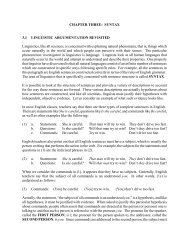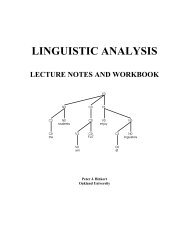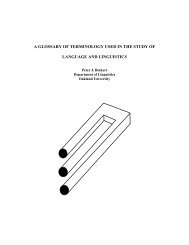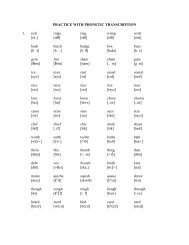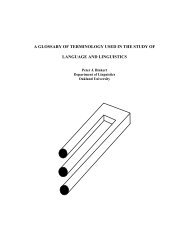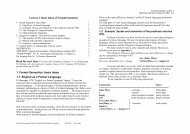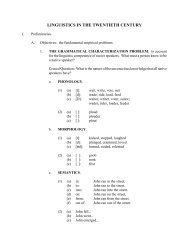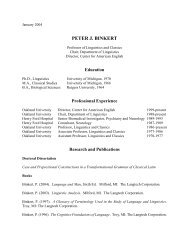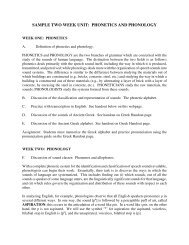- Page 1 and 2: LINGUISTIC STRUCTURES LECTURE NOTES
- Page 5 and 6: PREFACE This book is not a traditio
- Page 7 and 8: TABLE OF CONTENTS Introduction: Lin
- Page 9 and 10: Exercises for Chapter Three .......
- Page 11 and 12: INTRODUCTION: LINGUISTICS AND THE J
- Page 13 and 14: today’s job market. There is also
- Page 15 and 16: complex, interacting issues develop
- Page 17 and 18: circumstances when no single approa
- Page 19 and 20: (8) a. *Them frightened she. b. *He
- Page 21 and 22: In the above illustration, if stude
- Page 23 and 24: is worth noting here that people, i
- Page 25 and 26: like raise, which ends in a [z] (vo
- Page 27 and 28: phonology is exactly what we did wi
- Page 29 and 30: The ability to solve problems, to o
- Page 31: Work with dictionaries (lexicograph
- Page 35 and 36: acquire a native language because t
- Page 37 and 38: (18) a. Question: Why did they come
- Page 39 and 40: grammars prescribe what one should
- Page 41 and 42: At this point, let us consider only
- Page 43 and 44: The obvious reason that human langu
- Page 45 and 46: consonant sounds. The number and ty
- Page 47 and 48: (38) a. [Something] pleased the coa
- Page 49 and 50: (43) a. [+ANTERIOR] articulated in
- Page 51 and 52: (51) a. Assimilate [+NASAL] consona
- Page 53 and 54: constraints on human articulation.
- Page 55 and 56: (55) Statements Direct Questions Un
- Page 57 and 58: Given data like the above, it is cl
- Page 59 and 60: explanatory adequacy because it rel
- Page 61 and 62: g. They are all finished. h. They d
- Page 63 and 64: 8. Here are two typical definitions
- Page 65 and 66: CHAPTER TWO: PHONETICS AND PHONOLOG
- Page 67 and 68: distinguished from those that don
- Page 69 and 70: • BACK - NONBACK — Back sounds
- Page 71 and 72: The superscript “h” in the tran
- Page 73 and 74: The definitions for the remaining d
- Page 75 and 76: 2.1.4 REVIEW OF ISSUES At this poin
- Page 77 and 78: For many students, the study of lan
- Page 79 and 80: The last syllable is called the ULT
- Page 81 and 82: stub, skin, school, the t and k sou
- Page 83 and 84:
As we have had occasion to notice m
- Page 85 and 86:
FIGURE SEVEN: PHONOLOGICAL AND PHON
- Page 87 and 88:
In addition to specific phonotactic
- Page 89 and 90:
2.5 THE BIOLOGICAL BASIS OF PHONOLO
- Page 91 and 92:
This issue is important enough to r
- Page 93 and 94:
Clearly, a rule like (36) will be n
- Page 95 and 96:
2.5.3 THIRD SET OF OBSERVATIONS Sum
- Page 97 and 98:
To these forms, various stress rule
- Page 99 and 100:
2.8 SUMMARY OF RULE FORMALISM SYMBO
- Page 101 and 102:
NASALS: SUMMARY OF ENGLISH SOUNDS A
- Page 103 and 104:
weird feared veered cared cord meat
- Page 105 and 106:
3. Transcribe the following words i
- Page 107 and 108:
6. In each of the following, supply
- Page 109 and 110:
. [k], [õ], [h], [g] Choice: Class
- Page 111 and 112:
11. In Classical Latin, nouns have
- Page 113 and 114:
APPENDIX A: ANSWERS TO TRANSCRIPTIO
- Page 115 and 116:
2. music physics psychic sonic heli
- Page 117 and 118:
endevous residue peekaboo honeydew
- Page 119 and 120:
5. a. Palatalize all alveolar stops
- Page 121 and 122:
1. Data. APPENDIX C: SLASH-DASH NOT
- Page 123 and 124:
APPENDIX E: MORPHOLOGY PROBLEM Cons
- Page 125 and 126:
(1) Root /æg/ ‘do’: APPENDIX G
- Page 127 and 128:
CHAPTER THREE: SYNTAX 3.1 LINGUISTI
- Page 129 and 130:
pronoun. We know that is correct be
- Page 131 and 132:
Given these examples, it appears th
- Page 133 and 134:
(27) a. *My niece hit the busses st
- Page 135 and 136:
(34) a. John has the Spanish histor
- Page 137 and 138:
Given the reality of the chunk in p
- Page 139 and 140:
If AUX is part of the VERB PHRASE,
- Page 141 and 142:
(51) a. Generally the passengers mu
- Page 143 and 144:
A categories like VP (Verb Phrase)
- Page 145 and 146:
Additional facts about tense that n
- Page 147 and 148:
3.5 DETERMINERS AND THE INTERNAL ST
- Page 149 and 150:
The grammar we are developing must
- Page 151 and 152:
noun like John or child can only be
- Page 153 and 154:
indicating that the change is justi
- Page 155 and 156:
3.6 THE ENDOCENTRICITY CONSTRAINT P
- Page 157 and 158:
3.7 THE LEXICON In order to generat
- Page 159 and 160:
y quantifier nouns and POS can only
- Page 161 and 162:
center are due to Copernicus (1473-
- Page 163 and 164:
analysis ignores the fact that NP
- Page 165 and 166:
Note that each bracket on the left
- Page 167 and 168:
The data that we have observed and
- Page 169 and 170:
Given these structures, we can make
- Page 171 and 172:
The problem with the structures (14
- Page 173 and 174:
. He decided on the boat. (on the b
- Page 175 and 176:
With this revision, we can diagram
- Page 177 and 178:
With all the above revisions, it is
- Page 179 and 180:
Summarizing, we have the following
- Page 181 and 182:
The feature [+VBL] specifies those
- Page 183 and 184:
(history in teacher of history and
- Page 185 and 186:
(185) a. b. (186) a. b. The structu
- Page 187 and 188:
(191) a. *The school show play here
- Page 189 and 190:
The representations in (194) and (1
- Page 191 and 192:
Observe again that, by convention,
- Page 193 and 194:
FIGURE EIGHT: FEATURES FOR ENGLISH
- Page 195 and 196:
As the above diagrams show, the mos
- Page 197 and 198:
(212) a. the Spanish Spanish teache
- Page 199 and 200:
The existence of V1 (direct object
- Page 201 and 202:
3.13 TRANSFORMATIONAL GENERATIVE GR
- Page 203 and 204:
(230) This produces the sentence (2
- Page 205 and 206:
discussion, we have been trying to
- Page 207 and 208:
In (241), the empty N3 most immedia
- Page 209 and 210:
(250) THE EMPTY CATEGORY CONDITION
- Page 211 and 212:
Consider now a sentence like (268),
- Page 213 and 214:
3.16 THE ENGLISH AUXILIARY 3.16.1 T
- Page 215 and 216:
(277) TNS + V PST + hunt .)))0)))hu
- Page 217 and 218:
(284) An negative (not) can modify
- Page 219 and 220:
(294) The PROG and PASS can occur,
- Page 221 and 222:
(300) a. The lady was imposing (PRO
- Page 223 and 224:
(312) The order must be V1 level el
- Page 225 and 226:
(321) a. All of the men could have
- Page 227 and 228:
3.16.4 SUMMARY OF NOMINALS AND VERB
- Page 229 and 230:
(338) Future Tense: he will intervi
- Page 231 and 232:
(342) Past Tense + Passive Voice: t
- Page 233 and 234:
(344) Conditional Tense + Perfectiv
- Page 235 and 236:
(346) Conditional Tense + Perfectiv
- Page 237 and 238:
EXERCISES FOR CHAPTER THREE 1. Draw
- Page 239 and 240:
Provide disambiguating diagrams for
- Page 241 and 242:
APPENDIX A: ANSWERS TO EXERCISES 1.
- Page 243 and 244:
h. The boy could take the garbage o
- Page 245 and 246:
4. All of the following sentences h
- Page 247 and 248:
(2) = The man will look the street
- Page 249 and 250:
7. Draw RG diagrams for the followi
- Page 251 and 252:
h. The boy could take the garbage o
- Page 253 and 254:
c. They will probably read the assi
- Page 255 and 256:
. Ron left the house messy. (1) = T
- Page 257 and 258:
d. The prisoner of war spoke foolis
- Page 259 and 260:
APPENDIX B: LATIN SYNTAX Latin verb
- Page 261 and 262:
APPENDIX C: SUMMARY OF TREE STRUCTU
- Page 263 and 264:
7. Sentence with an intransitive (J
- Page 265 and 266:
4.1 PRELIMINARY REMARKS CHAPTER FOU
- Page 267 and 268:
(3) a. We were shooting the breeze.
- Page 269 and 270:
. The baby is too young to stand up
- Page 271 and 272:
The role of a noun phrase in relati
- Page 273 and 274:
e. If all three cases occur, either
- Page 275 and 276:
Unfortunately, there is even furthe
- Page 277 and 278:
In ancient Greek, which has no abla
- Page 279 and 280:
(40) Latin (same grammatical case,
- Page 281 and 282:
(46) Finnish (same grammatical case
- Page 283 and 284:
4.12 POSITIONAL THEMATIC RELATIONS
- Page 285 and 286:
To account for the differences betw
- Page 287 and 288:
-DSJ -CNJ +DSJ +CNJ -DSJ +CNJ +DSJ
- Page 289 and 290:
(56) a. He turned into a street. [+
- Page 291 and 292:
The definitions for the major nonpo
- Page 293 and 294:
(72) AFFERENTIAL (AFR): The quasi-p
- Page 295 and 296:
(80) a. ATTRIBUTIVE: He is black. b
- Page 297 and 298:
(89) a. BIRD4: robin A robin is a b
- Page 299 and 300:
cannot be derived from the (literal
- Page 301 and 302:
(97) [PST2]: live in luxury 291 a.
- Page 303 and 304:
(101) a. +PST POSITIONAL INVOLVING
- Page 305 and 306:
As a further example, consider the
- Page 307 and 308:
EXERCISES FOR CHAPTER FOUR In many
- Page 309 and 310:
4. What other tests than those in E
- Page 311 and 312:
10. The following uses of the ABLAT
- Page 313 and 314:
2. RG SEMANTICS: a. [+POSITIONAL] [
- Page 315 and 316:
CHAPTER FIVE: LANGUAGE, PEOPLE, AND
- Page 317 and 318:
(5) all those many young philosophe
- Page 319 and 320:
number is, interestingly, the lower
- Page 321 and 322:
(12) I know that (CPL) that (DET) m
- Page 323 and 324:
Given the above data, the RG analys
- Page 325 and 326:
(25) a. John called a former girl f
- Page 327 and 328:
In V3, complementizers are also a B
- Page 329 and 330:
(32) a. If a barrier is a free resi
- Page 331 and 332:
Given the Ø-analysis, we say that
- Page 333 and 334:
Summarizing, we have the following
- Page 335 and 336:
educes all phrases and clauses to v
- Page 337 and 338:
(60) a. C-command: a category α C-
- Page 339 and 340:
(69) a. Bob told himself that Ann l
- Page 341 and 342:
e. Bob told Ann that Sue liked her.
- Page 343 and 344:
(74) The behavior of floating quant
- Page 345 and 346:
Also: N3 w is the subject of both w
- Page 347 and 348:
EXERCISES FOR CHAPTER FIVE 1. Accou
- Page 349 and 350:
SUPPLEMENT ONE: THE NATURE OF HUMAN
- Page 351 and 352:
B. The GRAMMATICAL REALIZATION PROB
- Page 353 and 354:
(2) The differentiation of word cla
- Page 355 and 356:
II. THEORIES OF LANGUAGE. A. Myths.
- Page 357 and 358:
III. The theory of LINGUISTIC UNIVE
- Page 359 and 360:
B. FORMAL UNIVERSALS: stipulations
- Page 361 and 362:
2. MORPHOLOGY. a. (1) [t]: kicked,
- Page 363 and 364:
D. The generality of linguistics un
- Page 365 and 366:
3. Ellipsis. a. Linguistic. (1) Joh
- Page 367 and 368:
5. Complexity. a. Linguistic. (1) P
- Page 369 and 370:
6. Incongruity. a. Linguistic. (1)
- Page 371 and 372:
E. Linguistic universals and human
- Page 373 and 374:
IV. TYPES OF LANGUAGES. A. Classifi
- Page 375 and 376:
. PARAPHRASE (one meaning, more the
- Page 377 and 378:
B. Innovations in the STRUCTURE of
- Page 379 and 380:
C. Innovations in the FUNCTIONING o
- Page 381 and 382:
SUPPLEMENT TWO: GRAMMAR REVIEW SYNT
- Page 383 and 384:
CONJUNCTION: A conjunction is a wor
- Page 385 and 386:
SOME INFLECTIONAL CATEGORIES PERSON
- Page 387 and 388:
SUPPLEMENT THREE (PART II): TYPOLOG
- Page 389 and 390:
ALTAIC: SUPPLEMENT FOUR (PART II):
- Page 391 and 392:
SUPPLEMENT FIVE (PART II): AMERICAN
- Page 393 and 394:
SUPPLEMENT FIVE (PART IV): LANGUAGE
- Page 395 and 396:
SUPPLEMENT SIX: LANGUAGES AND LANGU
- Page 397 and 398:
SUPPLEMENT SEVEN: SOME ALPHABETS RO
- Page 399 and 400:
SUPPLEMENT EIGHT: SAMPLE PARSES FRO
- Page 401 and 402:
(3) COPULATIVE (PREDICATE COMPLEMEN
- Page 403 and 404:
(5) INTRANSITIVE WITH A MANNER ADVE
- Page 405 and 406:
(7) TRANSITIVE (DIRECT OBJECT + MAN
- Page 407 and 408:
(9) fred left the country happy a.
- Page 409 and 410:
(10) TRANSITIVE (DIRECT OBJECT + IN
- Page 411 and 412:
(12) TRANSITIVE (DOUBLE OBJECT): sh
- Page 413 and 414:
(14) TRANSITIVE (SENTENTIAL COMPLEM
- Page 415 and 416:
(16) TRANSITIVE (SENTENTIAL COMPLEM
- Page 417 and 418:
(17) TRANSITIVE (SENTENTIAL COMPLEM
- Page 419 and 420:
(19) TRANSITIVE (SENTENTIAL COMPLEM
- Page 421 and 422:
(21) TRANSITIVE (DIRECT OBJECT + S
- Page 423 and 424:
(23) TRANSITIVE (DIRECT OBJECT + S
- Page 425 and 426:
(25) TRANSITIVE (DIRECT OBJECT + S
- Page 427 and 428:
(27) TRANSITIVE (PREPOSITIONAL PHRA
- Page 429 and 430:
(29) TRANSITIVE (PREPOSITIONAL PHRA
- Page 431 and 432:
(31) TRANSITIVE (DIRECT OBJECT + PA
- Page 433 and 434:
(33) TRANSITIVE (COMPLEMENTARY INFI
- Page 435 and 436:
(35) TRANSITIVE (PREPOSITIONAL OBJE
- Page 437 and 438:
SUPPLEMENT NINE: SAMPLE PARSES FROM
- Page 439 and 440:
(4) All those many nosey house gues
- Page 441 and 442:
SUPPLEMENT TEN: SAMPLE PARSES FROM
- Page 443 and 444:
(3) Saturn’s rings are believed t
- Page 445 and 446:
(2) Passive Participles (-en) and D
- Page 447 and 448:
(4) Summary of Verbal Structures. a
- Page 449 and 450:
(6) TRANSITIVE (DIRECT OBJECT + PAS
- Page 451 and 452:
(8) AMBIGUITY: i heard the tenor si
- Page 453 and 454:
INDEX Abstract Noun ...............
- Page 455 and 456:
Denotation ........................
- Page 457 and 458:
Low ...............................
- Page 459 and 460:
Phrase Structure Filter ...........
- Page 461 and 462:
Trace .............................
- Page 463 and 464:
NOTES 453
- Page 465 and 466:
NOTES 455
- Page 467 and 468:
NOTES 457



